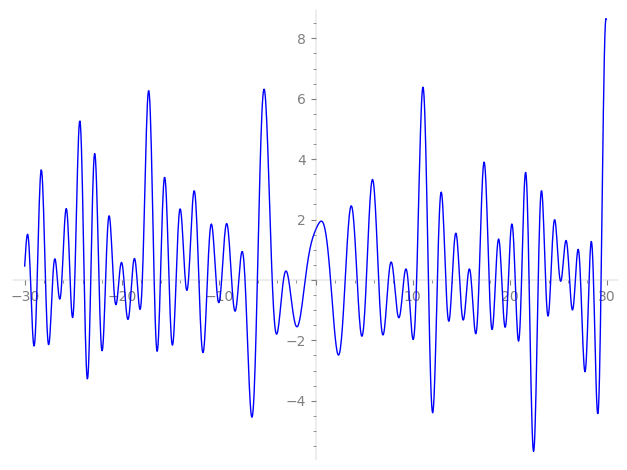| L(s) = 1 | + (−0.5 − 0.866i)2-s + (1.71 − 0.211i)3-s + (−0.499 + 0.866i)4-s + (−0.5 + 0.866i)5-s + (−1.04 − 1.38i)6-s + (−0.5 − 0.866i)7-s + 0.999·8-s + (2.91 − 0.728i)9-s + 0.999·10-s + (−1.04 − 1.80i)11-s + (−0.675 + 1.59i)12-s + (1.54 − 2.67i)13-s + (−0.499 + 0.866i)14-s + (−0.675 + 1.59i)15-s + (−0.5 − 0.866i)16-s + 1.64·17-s + ⋯ |
| L(s) = 1 | + (−0.353 − 0.612i)2-s + (0.992 − 0.122i)3-s + (−0.249 + 0.433i)4-s + (−0.223 + 0.387i)5-s + (−0.425 − 0.564i)6-s + (−0.188 − 0.327i)7-s + 0.353·8-s + (0.970 − 0.242i)9-s + 0.316·10-s + (−0.314 − 0.544i)11-s + (−0.195 + 0.460i)12-s + (0.427 − 0.741i)13-s + (−0.133 + 0.231i)14-s + (−0.174 + 0.411i)15-s + (−0.125 − 0.216i)16-s + 0.399·17-s + ⋯ |
\[\begin{aligned}\Lambda(s)=\mathstrut & 630 ^{s/2} \, \Gamma_{\C}(s) \, L(s)\cr =\mathstrut & (0.407 + 0.913i)\, \overline{\Lambda}(2-s) \end{aligned}\]
\[\begin{aligned}\Lambda(s)=\mathstrut & 630 ^{s/2} \, \Gamma_{\C}(s+1/2) \, L(s)\cr =\mathstrut & (0.407 + 0.913i)\, \overline{\Lambda}(1-s) \end{aligned}\]
Particular Values
| \(L(1)\) |
\(\approx\) |
\(1.39860 - 0.907272i\) |
| \(L(\frac12)\) |
\(\approx\) |
\(1.39860 - 0.907272i\) |
| \(L(\frac{3}{2})\) |
|
not available |
| \(L(1)\) |
|
not available |
\(L(s) = \displaystyle \prod_{p} F_p(p^{-s})^{-1} \)
| $p$ | $F_p(T)$ |
|---|
| bad | 2 | \( 1 + (0.5 + 0.866i)T \) |
| 3 | \( 1 + (-1.71 + 0.211i)T \) |
| 5 | \( 1 + (0.5 - 0.866i)T \) |
| 7 | \( 1 + (0.5 + 0.866i)T \) |
| good | 11 | \( 1 + (1.04 + 1.80i)T + (-5.5 + 9.52i)T^{2} \) |
| 13 | \( 1 + (-1.54 + 2.67i)T + (-6.5 - 11.2i)T^{2} \) |
| 17 | \( 1 - 1.64T + 17T^{2} \) |
| 19 | \( 1 - 4.52T + 19T^{2} \) |
| 23 | \( 1 + (-1.19 + 2.06i)T + (-11.5 - 19.9i)T^{2} \) |
| 29 | \( 1 + (-0.895 - 1.55i)T + (-14.5 + 25.1i)T^{2} \) |
| 31 | \( 1 + (-2.43 + 4.22i)T + (-15.5 - 26.8i)T^{2} \) |
| 37 | \( 1 - 9.90T + 37T^{2} \) |
| 41 | \( 1 + (3.74 - 6.48i)T + (-20.5 - 35.5i)T^{2} \) |
| 43 | \( 1 + (0.413 + 0.716i)T + (-21.5 + 37.2i)T^{2} \) |
| 47 | \( 1 + (1.64 + 2.85i)T + (-23.5 + 40.7i)T^{2} \) |
| 53 | \( 1 + 3.73T + 53T^{2} \) |
| 59 | \( 1 + (5.17 - 8.96i)T + (-29.5 - 51.0i)T^{2} \) |
| 61 | \( 1 + (1.21 + 2.11i)T + (-30.5 + 52.8i)T^{2} \) |
| 67 | \( 1 + (5.70 - 9.87i)T + (-33.5 - 58.0i)T^{2} \) |
| 71 | \( 1 + 15.6T + 71T^{2} \) |
| 73 | \( 1 - 1.70T + 73T^{2} \) |
| 79 | \( 1 + (-0.351 - 0.609i)T + (-39.5 + 68.4i)T^{2} \) |
| 83 | \( 1 + (3.73 + 6.46i)T + (-41.5 + 71.8i)T^{2} \) |
| 89 | \( 1 + 2.34T + 89T^{2} \) |
| 97 | \( 1 + (-3.93 - 6.82i)T + (-48.5 + 84.0i)T^{2} \) |
| show more | |
| show less | |
\(L(s) = \displaystyle\prod_p \ \prod_{j=1}^{2} (1 - \alpha_{j,p}\, p^{-s})^{-1}\)
Imaginary part of the first few zeros on the critical line
−10.27486353349283521976105673167, −9.700264481197891596266176537424, −8.670509560609899590597654534923, −7.930648617915324722266404351882, −7.28721762281056321659051827415, −6.01537180678640738105815202518, −4.48576990352188606176268523390, −3.32649012175288685656479027039, −2.78700241396403781626685291726, −1.08460016557594220283305499380,
1.52979587573625713879998115800, 3.03751856035070876076257029286, 4.27310847496562127988847521495, 5.21676780385973644524711758009, 6.48441459582091330734917048040, 7.48846811818148738494840178797, 8.078686554119714666859491751749, 9.077537322894632697842039194078, 9.508974515271850290955870788310, 10.40221380394177598897547736541

